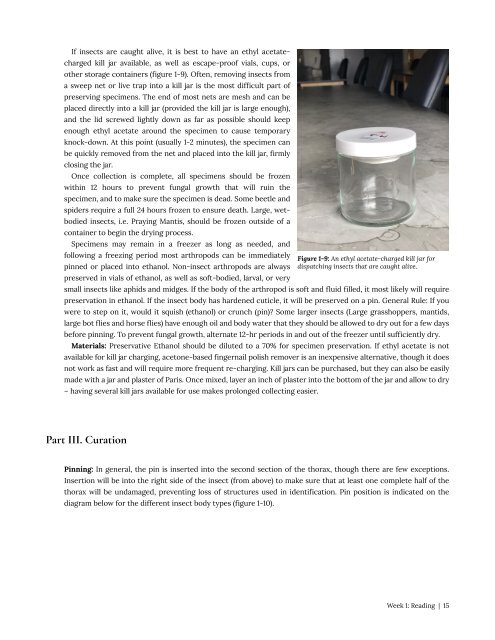Entomology 311 Lab Manual - 1st Edition, 2019
Entomology 311 Lab Manual - 1st Edition, 2019
Entomology 311 Lab Manual - 1st Edition, 2019
Create successful ePaper yourself
Turn your PDF publications into a flip-book with our unique Google optimized e-Paper software.
If insects are caught alive, it is best to have an ethyl acetatecharged<br />
kill jar available, as well as escape-proof vials, cups, or<br />
other storage containers (figure 1-9). Often, removing insects from<br />
a sweep net or live trap into a kill jar is the most difficult part of<br />
preserving specimens. The end of most nets are mesh and can be<br />
placed directly into a kill jar (provided the kill jar is large enough),<br />
and the lid screwed lightly down as far as possible should keep<br />
enough ethyl acetate around the specimen to cause temporary<br />
knock-down. At this point (usually 1-2 minutes), the specimen can<br />
be quickly removed from the net and placed into the kill jar, firmly<br />
closing the jar.<br />
Once collection is complete, all specimens should be frozen<br />
within 12 hours to prevent fungal growth that will ruin the<br />
specimen, and to make sure the specimen is dead. Some beetle and<br />
spiders require a full 24 hours frozen to ensure death. Large, wetbodied<br />
insects, i.e. Praying Mantis, should be frozen outside of a<br />
container to begin the drying process.<br />
Specimens may remain in a freezer as long as needed, and<br />
following a freezing period most arthropods can be immediately<br />
pinned or placed into ethanol. Non-insect arthropods are always<br />
preserved in vials of ethanol, as well as soft-bodied, larval, or very<br />
Figure 1-9: An ethyl acetate-charged kill jar for<br />
dispatching insects that are caught alive.<br />
small insects like aphids and midges. If the body of the arthropod is soft and fluid filled, it most likely will require<br />
preservation in ethanol. If the insect body has hardened cuticle, it will be preserved on a pin. General Rule: If you<br />
were to step on it, would it squish (ethanol) or crunch (pin)? Some larger insects (Large grasshoppers, mantids,<br />
large bot flies and horse flies) have enough oil and body water that they should be allowed to dry out for a few days<br />
before pinning. To prevent fungal growth, alternate 12-hr periods in and out of the freezer until sufficiently dry.<br />
Materials: Preservative Ethanol should be diluted to a 70% for specimen preservation. If ethyl acetate is not<br />
available for kill jar charging, acetone-based fingernail polish remover is an inexpensive alternative, though it does<br />
not work as fast and will require more frequent re-charging. Kill jars can be purchased, but they can also be easily<br />
made with a jar and plaster of Paris. Once mixed, layer an inch of plaster into the bottom of the jar and allow to dry<br />
– having several kill jars available for use makes prolonged collecting easier.<br />
Part III. Curation<br />
Pinning: In general, the pin is inserted into the second section of the thorax, though there are few exceptions.<br />
Insertion will be into the right side of the insect (from above) to make sure that at least one complete half of the<br />
thorax will be undamaged, preventing loss of structures used in identification. Pin position is indicated on the<br />
diagram below for the different insect body types (figure 1-10).<br />
Week 1: Reading | 15


















